Morel Madness
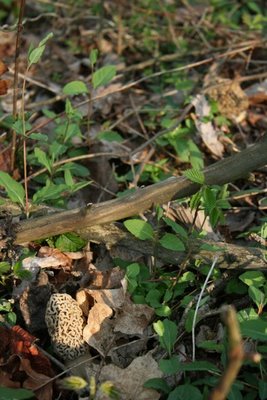 There are two white morels in the photo. Can you find them?
There are two white morels in the photo. Can you find them?It's MOREL TIME. Yes, I am shouting. I love MOREL TIME. I will say that, with the weather going from Februaryine conditions to Augustine in the space of 24 hours, it's a little tough on the morels. Bill and I went out twice a day, checking our honeyspots, looking, looking, finding nothing. And then I was riding the lawnmower, just pootling along, when I saw three wrinkled beings lined up right along our driveway. AGGH! Morels.
Here I am in the thrill of discovery. The tattoo on my arm is temporary. It is a muscle car with flames shooting out its butt, which I applied to my skin as inspiration, because I needed to empty the greenhouse and plant the vegetable garden in three days. Which I did. As you can tell from my stunning farmer sunburn.
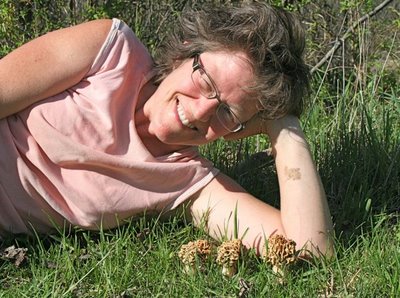 photo by Phoebe Linnea Thompson
photo by Phoebe Linnea ThompsonNot only did I empty the greenhouse, but I potted five large hanging baskets and nine planters, dug out and distributed reechy compost to all my garden beds, weeded several beds, rototilled the garden, planted the beans, glads, and tuberoses, and mowed the lawn. It was a heck of a weekend. Pretty much perfect by Zick standards, except that Bill wasn't here to share the joy.
On Saturday afternoon, when the lawn was mowed, I called to Phoebe to come join me in a search for more morels. We decided to hit new ground, near where I'd found the trio of monsters pictured above.
Phoebe finds her first one. The twig across her face doesn't hide her excitement.
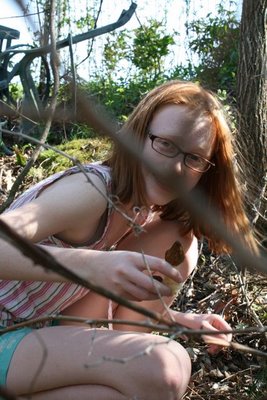
At this point I should say that we found two different species of morels. The white, or yellow morel Morchella esculenta is the most highly prized for its taste and texture. The two fabulously wrinkled, paler specimens at the top are white morels. They look more like a proper mushroom to me.
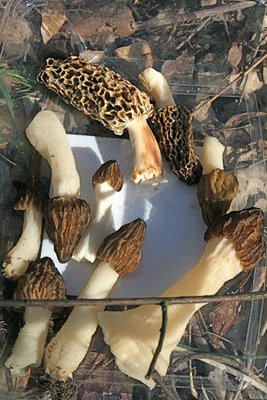 All the rest with the smaller brown caps are half-free morels, Morchella semilibera. They're perfectly good to eat and taste wonderful, but they don't hold up quite as well to cooking as does M. esculenta, being sort of gauzy and less substantial in texture. They're called half-free morels because the cap is attached to the stem halfway up, leaving the cap hanging down over the stem for half its length. White morels' caps are attached to the stem at the base. Both edible species have a hollow stem, which is the diagnostic characteristic that tells you they are safe to eat. If you find a morel that, on cross section, has a stem filled with white fuzzy hyphae, you've probably got Verpa bohemica, the False Morel, which you DO NOT want to eat.
All the rest with the smaller brown caps are half-free morels, Morchella semilibera. They're perfectly good to eat and taste wonderful, but they don't hold up quite as well to cooking as does M. esculenta, being sort of gauzy and less substantial in texture. They're called half-free morels because the cap is attached to the stem halfway up, leaving the cap hanging down over the stem for half its length. White morels' caps are attached to the stem at the base. Both edible species have a hollow stem, which is the diagnostic characteristic that tells you they are safe to eat. If you find a morel that, on cross section, has a stem filled with white fuzzy hyphae, you've probably got Verpa bohemica, the False Morel, which you DO NOT want to eat.Here is the yummy half-free morel, with its hollow stem, and cap connected halfway up. The stem has white pimples on the inside, but not cottony fibers:
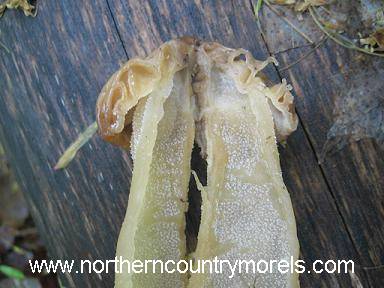
And here is Verpa bohemica, the False Morel, with its stem full of white cottony hyphae, its cap hanging free and attached only at the very top, and its nasty poisonousness. Don't eat this one.
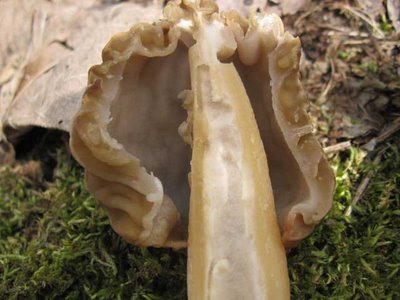
These photos lifted from Northern Country Morels, a wonderful web site full of wisdom and warnings.
Remember: There are old mushroom hunters, and bold mushroom hunters, but there are no old, bold mushroom hunters.
One of the half-free morel's common names is "peckerhead," and so are they called on Indigo Hill.
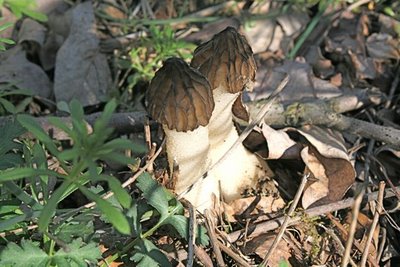 Phoebe gave me permission to use this picture of her holding a large half-free morel. Yes, she is her mother's daughter (and her father's daughter) through and through. Which is to say, irreverant and pleasantly evil, even at twelve. Heck, she was that way at three.
Phoebe gave me permission to use this picture of her holding a large half-free morel. Yes, she is her mother's daughter (and her father's daughter) through and through. Which is to say, irreverant and pleasantly evil, even at twelve. Heck, she was that way at three.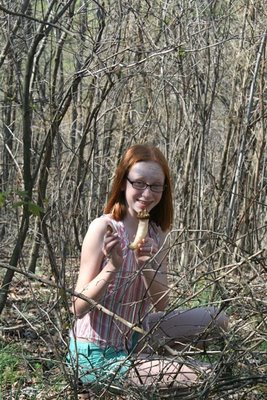 Farther out our orchard, near the rotting apple stumps, we found a sweet spot full of delicioius white morels.
Farther out our orchard, near the rotting apple stumps, we found a sweet spot full of delicioius white morels.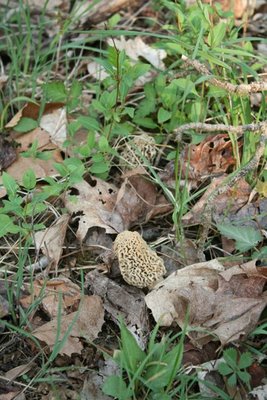 A tiger swallowtail, meet companion to the morel hunter. Look for them when the tigers are first flying in spring, when the fiddleheads push up from the earth.
A tiger swallowtail, meet companion to the morel hunter. Look for them when the tigers are first flying in spring, when the fiddleheads push up from the earth.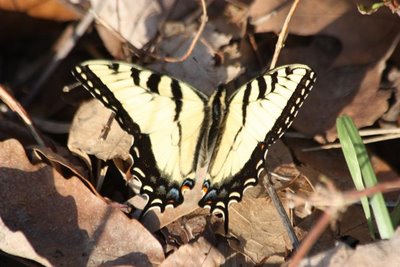
Thanks for coming morel hunting with us.
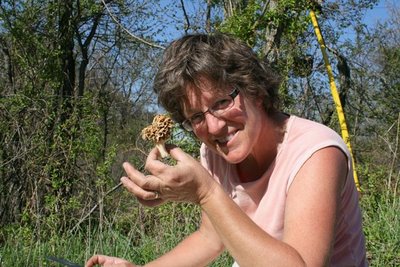 photo by Phoebe Linnea Thompson
photo by Phoebe Linnea ThompsonWe love you all, but this is about as close as you're going to get to our happy hunting grounds. Morels bring out the bad, possessive and evil in us.
Labels: false morel, half-free morel, morel hunting, Morel mushrooms, morels, white morel, yellow morel






<< Home